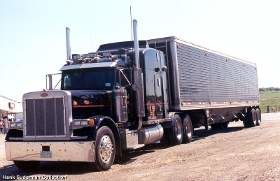Mountain Driving Without Engine Brake
Topic 6206 | Page 3
Brett, in regards to climbing a mountain in icy roads, what do you say? High or low rpm?
Brett, in regards to climbing a mountain in icy roads, what do you say? High or low rpm?
I used to keep it as close to the high end of the range as possible mainly because I wanted some leeway if the tires slipped a little bit.
If you're climbing a steep grade and your tires break loose even a little bit you're going to lose speed very quickly. Well if you're at 1,100 RPM's when it breaks loose (near the bottom of the working RPM range) you're going to have to downshift immediately. That's a disaster. Not only did you lose speed when the wheels lost traction but now you have to downshift which further delays your ability to put power to the ground and slows you even further. In that scenario you're almost certainly going to have to drop two gears unless you catch it very quickly. Now you're at a crawl. And that's assuming you nailed that downshift perfectly. Miss that downshift and you're just about coming to a complete stop. Disaster.
But if you're near the top of the RPM range and the tires start to break loose you can back off the gas a little bit and hopefully they'll catch again while you're still able to stay in the same gear. If that happens you'll often find yourself climbing again under full power in the same gear you were in, but now you're at the bottom of the RPM range near maximum torque and the truck should be able to maintain its speed no problem. If you were maintaining your speed near the high end of the RPM range where the torque values are lower then you'll certainly be able to maintain speed in that same gear with the RPM's down near maximum torque.
OOS:
When a violation by either a driver or company is confirmed, an out-of-service order removes either the driver or the vehicle from the roadway until the violation is corrected.

not sure if this will help but it seems to work
How To Handle A Steep Downhill Grade

Well, except when some super trucker went flying past me at 50, but that's a different story.
. . . speaking of, I was going downhill in Montana (I-90) on a wet but not frozen road (lots of salt in use), snow blowing around and about 19 degrees . . . the fast lane WAS covered in snow and I was moving at a pretty good clip behind a 4 wheeler . . . "Zoom!!" - a SuperTrucker passes both of us going (no exaggeration) 75 + on the snowpack in the fast lane (where do these balls of steel come from???) and I just shook my head in disbelief and foreboding . . . it got real foggy at the bottom of the hill about ten miles down the road . . . I see a Montana HP putting out flare stacks (where one flare starts the next one as they burn down) and has stuck a hand-held "SLOW" sign in the snow bank in order to warn oncoming traffic - viability about 200 yards at this point . . . up ahead we all come to a stop as about 10 rigs and 10 cars are in various arrangement of entanglement and in the ditch . . . and lo-and-behold our SuperTrucker had struck the trailer of another rig sitting astride the center meridian and both trucks have our lanes blocked . . . a snow plow driver has SuperTrucker pull farther off the road to let us mere mortals pass on by . . . his balls were not made of steel after all, his brains were made of mush . . .
Jopa



OWI:
Operating While Intoxicated
New Reply:
New! Check out our help videos for a better understanding of our forum features

















Preview:
This topic has the following tags:
Safe Driving Tips Tips For Braking







 TT On Facebook
TT On Facebook
I would say you're going to slow down a bit and downshift one gear on slick roads without a Jake brake versus dry roads with a Jake brake. I don't want to make my foot brake work quite that hard and I want to slow down further on slick roads. I mean, it's going to depend on a lot of things. But for me, if the roads were slick and I wasn't going to use the Jake brakes I would be one gear down from where I would be if I was using Jakes.